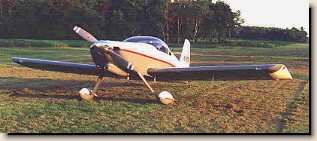Two Fatally Injured When The Plane Went Down
The NTSB has released a preliminary report from an accident involving a Vans RV-6 airplane which went down April 29 near Ridgefield, WA resulting in the fatal injury of the two people on board.

According to the report, the experimental, amateur-built Van's Aircraft RV-6 airplane, N90LK, impacted in shallow water near Ridgefield, Washington at an unknown time. The private pilot/owner and flight instructor were fatally injured, and the airplane sustained substantial damage. VFR conditions prevailed and no flight plan was filed. The flight originated from Grove Field Airport (1W1), Camas, Washington at 1402.
According to representatives of the Clark County (WA) Sheriff's Office, a pilot telephoned them about 1611 to advise that he observed a crashed airplane in a body of water just south of Daybreak Airport (W46), La Center, Washington. A ground check by law enforcement personnel located the wreckage about 1,000 ft south-southeast of the approach end of runway 31, and the two occupants were deceased. No witnesses to the accident have been located. According to the pilot/owner's wife, the purpose of the flight was to conduct the pilot's biennial flight review.
No radio communications between the airplane and any Federal Aviation Administration (FAA) air traffic control facilities have been located. A review of FAA ground tracking radar data revealed a series of radar returns that appeared to be associated with the accident airplane and flight. The first radar return was captured at 1404:28, and indicated that the airplane was located about 0.6 miles northeast of 1W1. No altitude data was associated with that return, but the next return (at 1404:33) indicated an altitude of 1,100 ft. The airplane climbed to and leveled off at about 1,500 ft for about 4 minutes. It then descended to about 1,300 ft for about 30 seconds, then climbed to about 2,400 ft for about 2 minutes, and then entered a steady descent to the end of the data. The last radar return was recorded 1413:42. At that time the airplane was at an altitude of 500 ft. The radar data indicated that the airplane tracked north-northwest towards W46, and then entered a track similar to a left downwind leg
for runway 13 that was offset about a half-mile to the east. The airplane then flew a left 180° turn, and flew a track approximating a close-in (about 0.2 miles) left downwind leg for runway 31. The last recorded return was situated on this leg, approximately midfield.
The field elevation of 1W1 was listed as 429 ft, and W46 as 25 ft. Published data indicated that right traffic patterns were to be used for both runway 13 and 31 at W46.
FAA records indicated that the accident airplane was built in 1990 by the accident pilot, and was equipped with a Lycoming O-320 series engine. The pilot held a private pilot certificate with an airplane single-engine land rating. His most recent FAA third-class medical certificate was issued in March 2017, at which time he reported a total flight experience of 1,500 hours. He also held an FAA Repairman Certificate for his RV-6 airplane.
FAA records indicated that the instructor held airline transport and flight instructor certificates with airplane instrument, airplane single-engine, and airplane multi-engine land ratings. He also held type ratings in six different turbojet models. His most recent FAA second-class medical certificate was issued in August 2018, at which time he reported a total flight experience of 20,000 hours.
The automated weather observations at an airport located about 10 miles west of the accident site, for the period 1353 to 1453, included winds from 060° at 6 knots or less, visibility 10 miles, and clear skies.
The automated weather observations at an airport located about 13 miles south of the accident site, for the period 1353 to 1453, included winds between 200° and 300° at 6 knots, visibility 10 miles, and clear skies.
(Source: NTSB. Image from file. Not accident airplane)
 SpaceX to Launch Inversion RAY Reentry Vehicle in Fall
SpaceX to Launch Inversion RAY Reentry Vehicle in Fall Aero-News: Quote of the Day (04.23.24)
Aero-News: Quote of the Day (04.23.24) Aero-News: Quote of the Day (04.20.24)
Aero-News: Quote of the Day (04.20.24) ANN's Daily Aero-Linx (04.20.24)
ANN's Daily Aero-Linx (04.20.24) Aero-News: Quote of the Day (04.21.24)
Aero-News: Quote of the Day (04.21.24)



